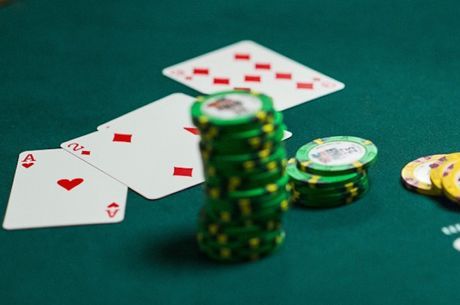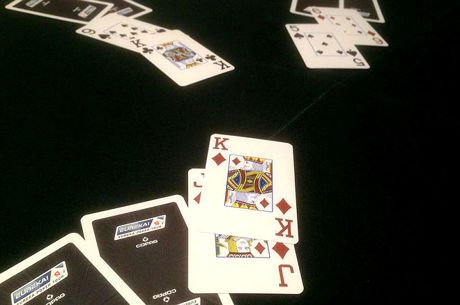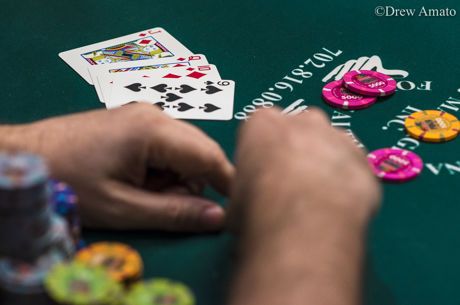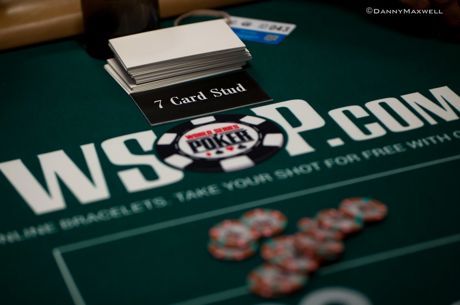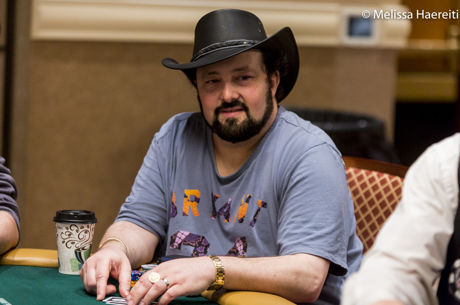Stud Poker Strategy: Time for a Quiz, Part 2

School has started. It's time for you to continue your poker exam.
For the questions below, assume a $20/40 game with a $3.00 ante and a $5.00 forced bet from the low card. Unless otherwise noted, the players are moderately aggressive and not particularly tight – especially on third street. Choose the answer that you think is correct most of the time. Answers will be provided at the very bottom of the article. Decide on your answer before scrolling down.
Question #1: It is the river. Your opponent has an exposed 3-flush that he hit on sixth street. You bet your exposed pair of eights on that street and he raised, representing a flush. You had just two pair, the exposed pair of eights and a wired pair of jacks that you had been betting since third street. You receive another eight, giving you a full house on the river.
Here are your hands on the river:
YOU: (J♦ J♠) 10♣ 8♦ 8♠ 2♣ (8♣)
HE: (x x) 7♥ 3♥ 4♣ 10♥ ( x )
You are high and have first action. You have a full house. You should:
a) check and call when he bets
b) check and raise when he bets
c) bet
d) check and fold when he bets
Question #2: It is the river. You started off with an ace-high and tried to steal the ante with a bet. You failed; three people called you. On fourth street you received a ten that paired a ten you had in the hole. You bet again and were called by three people. On fifth street you hit a king and were high and bet again. Two players called you again. On sixth street you didn't improve but you hit your third suited up card. You bet again. One player folded and the other called. On the river you didn't improve. As unlikely as it seemed, this is what you saw.
HE: (x x) J♠ 9♠ Q♠ 10♠ ( x )
You have a pair of tens. Two spades and a king have been folded. You are still high with your exposed ace. The betting action is to you. What do you do?
a) check and call when your opponent bets
b) bet
c) check and fold when your opponent bets
d) check and raise when your opponent bets
Question # 3: You were drawing to a flush, missed, but paired your exposed ace on the river. Two players and you remain. A player with an exposed pair of kings, who had been betting the whole way, bets. You are next to act. You believe, based on the betting that has already occurred, that the player after you is drawing for a flush while the other has either one or two pair or is drawing to a straight.
The player in front of you, with the exposed pair of kings, bets. You are next to act. You should:
a) call
b) fold
c) raise
d) double down
Question #4: It's the river. You have been betting your split pair of aces. Your lone opponent has been calling with what appears to be a flush draw. His first two exposed cards are the same suit. You get a second pair to give you aces up.
You are high on board. You should:
a) check and call if your opponent bets
b) bet
c) check and fold if your opponent bets
d) check and raise if your opponent bets
ANSWERS:
Answer #1: You hit a full house on the river. If you are reading the hand correctly you know that your opponent hit a flush. You want to maximize the money you will make. You don't want to check and call – that is much too timid. You surely don't want to check and fold with the best hand. Betting is also the wrong play – expecting your opponent to call you. If you bet you strongly suspect he'll call you, since he is smart enough to realize you might have made a full house (if you were playing with a poor player who tends to overvalue his hand you might bet, hope he raises, and then re-raise. But that is not the case here when you're playing with regular $20/40 players). If you check, you strongly suspect he'll bet his flush – just as he raised you on sixth street. This is a good time for that check-raise – so you can make two bets instead of one. The correct answer is b.
Answer #2: Your opponent looks like he must surely have your pair of tens beaten. He has four to a straight flush on board. He could have a straight, a flush, a straight flush, a higher pair or two pair. You surely don't want to bet and risk being raised if he hit a large hand. For the same reason it would be a big mistake to raise him if he bets after you check. Even so, the pot is enormous. It was multi-way all the way to sixth street with betting on every street. You are getting at least thirteen to one odds for your call. You can't be more than 20% sure that he has you beaten since there's at least some reasonable chance that he's betting as a bluff to steal the huge pot. It is better to make the relatively small mistake of calling a hand that beats you than to fold incorrectly and lose this enormous pot. The correct answer is: a.
Answer #3: You have a pair of aces. But someone bets in front of you into two of you. It would be extremely unlikely that he would do this if he couldn't at least beat a pair. Even if he could bluff one of you, he wouldn't try to bluff you both – not with one of you drawing to a flush. This is known as a protected pot – and the pot is protected from a bluff because both of you are in it. Even though it feels bad to fold, give him credit for at least two pair, and probably a lot stronger. The correct answer is: b.
Answer #4: Many players think that it doesn't make sense to bet into a flush draw on the river, since they surmise that their opponent will raise if he hits and fold if he misses. This is a mistake. Your drawing opponent may well call you with hands that can't beat aces up. He could have a high pair and think you're bluffing. He could hit a lower two pair. The times he hits you and raises will be much less frequent than those times he will call you. Don't miss an opportunity to make that extra bet on the river. The correct answer is: b.
Give yourself five points for every correct answer. Deduct five points if you answered "d" to any of the questions. If you scored 15 or higher, congratulations, you passed. Anything less and you'll need to brush up on your stud strategy. Feel free to purchase my book Winning 7-card Stud from Amazon.com or email me with questions.





